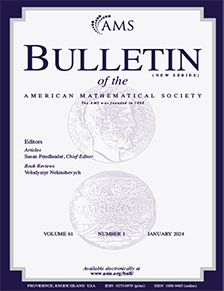From superconductors and four-manifolds to weak interactions
HTML articles powered by AMS MathViewer
- by Edward Witten PDF
- Bull. Amer. Math. Soc. 44 (2007), 361-391 Request permission
Abstract:
The goal of this article is to describe the concept of “gauge symmetry breaking” and its applications to superconductors, four-manifold theory, and particle physics.References
- P. W. Anderson, Plasmons, gauge invariance, and mass, Phys. Rev. (2) 130 (1963), 439–442. MR 153388, DOI 10.1103/PhysRev.130.439
- J. Bardeen, L. N. Cooper, and J. R. Schrieffer, Theory of superconductivity, Phys. Rev. (2) 108 (1957), 1175–1204. MR 95694, DOI 10.1103/PhysRev.108.1175
- E. B. Bogomol′nyĭ, The stability of classical solutions, Jadernaja Fiz. 24 (1976), no. 4, 861–870 (Russian); English transl., Soviet J. Nuclear Phys. 24 (1976), no. 4, 449–454. MR 0443719 D P. A. M. Dirac, “The Quantum Theory of the Electron,” Proc. Roy. Soc. (London) A117 (1928) 610.
- S. K. Donaldson, Polynomial invariants for smooth four-manifolds, Topology 29 (1990), no. 3, 257–315. MR 1066174, DOI 10.1016/0040-9383(90)90001-Z
- F. Englert and R. Brout, Broken symmetry and the mass of gauge vector mesons, Phys. Rev. Lett. 13 (1964), 321–323. MR 174314, DOI 10.1103/PhysRevLett.13.321 GL V. Ginzburg and L. Landau, “On the Theory of Superconductivity,” JETP 20 (1950) 1064-1082. GGH. Georgi and S. L. Glashow, “Unity of All Elementary Particle Forces,” Phys. Rev. Lett. 32 (1974) 438-441. GlS. L. Glashow, “Partial Symmetries of Weak Interactions,” Nucl. Phys. 22 (1961) 579-588.
- M. Gromov, Pseudo holomorphic curves in symplectic manifolds, Invent. Math. 82 (1985), no. 2, 307–347. MR 809718, DOI 10.1007/BF01388806 LEP LEP Electroweak Working Group, http://lepewwg.web.cern.ch/LEPEWWG/.
- Peter W. Higgs, Broken symmetries and the masses of gauge bosons, Phys. Rev. Lett. 13 (1964), 508–509. MR 175554, DOI 10.1103/PhysRevLett.13.508
- Gregory Moore and Edward Witten, Integration over the $u$-plane in Donaldson theory, Adv. Theor. Math. Phys. 1 (1997), no. 2, 298–387. MR 1605636, DOI 10.4310/ATMP.1997.v1.n2.a7
- A. Salam and J. C. Ward, Electromagnetic and weak interactions, Phys. Lett. 13 (1964), 168–171. MR 192825, DOI 10.1016/0031-9163(64)90711-5 S A. Salam, “Weak and Electromagnetic Interactions,” in N. Svartholm, ed., Elementary Particle Physics (Almqvist and Wiksells, Stockholm, 1968), 367-377.
- Julian Schwinger, Gauge invariance and mass, Phys. Rev. (2) 125 (1962), 397–398. MR 154597, DOI 10.1103/PhysRev.125.397
- Alexandru Scorpan, The wild world of 4-manifolds, American Mathematical Society, Providence, RI, 2005. MR 2136212
- N. Seiberg and E. Witten, Electric-magnetic duality, monopole condensation, and confinement in $N=2$ supersymmetric Yang-Mills theory, Nuclear Phys. B 426 (1994), no. 1, 19–52. MR 1293681, DOI 10.1016/0550-3213(94)90124-4
- Clifford Henry Taubes, Arbitrary $N$-vortex solutions to the first order Ginzburg-Landau equations, Comm. Math. Phys. 72 (1980), no. 3, 277–292. MR 573986, DOI 10.1007/BF01197552
- Clifford Henry Taubes, The Seiberg-Witten and Gromov invariants, Math. Res. Lett. 2 (1995), no. 2, 221–238. MR 1324704, DOI 10.4310/MRL.1995.v2.n2.a10
- Clifford Henry Taubes, Seiberg Witten and Gromov invariants for symplectic $4$-manifolds, First International Press Lecture Series, vol. 2, International Press, Somerville, MA, 2000. Edited by Richard Wentworth. MR 1798809 W S. Weinberg, “A Model of Leptons,” Phys. Rev. Lett. 19 (1967) 1264. Wtwo S. Weinberg, The Quantum Theory of Fields, volumes 1 and 2 (Cambridge University Press, 1996).
Additional Information
- Edward Witten
- Affiliation: School of Natural Sciences, Institute for Advanced Study, Princeton, New Jersey 08540
- MR Author ID: 183820
- Email: witten@ias.edu
- Received by editor(s): February 26, 2007
- Published electronically: April 23, 2007
- Additional Notes: Supported in part by NSF Grant PHY-0503584.
- © Copyright 2007 American Mathematical Society
- Journal: Bull. Amer. Math. Soc. 44 (2007), 361-391
- MSC (2000): Primary 81Q99, 53D45
- DOI: https://doi.org/10.1090/S0273-0979-07-01167-6
- MathSciNet review: 2318156


